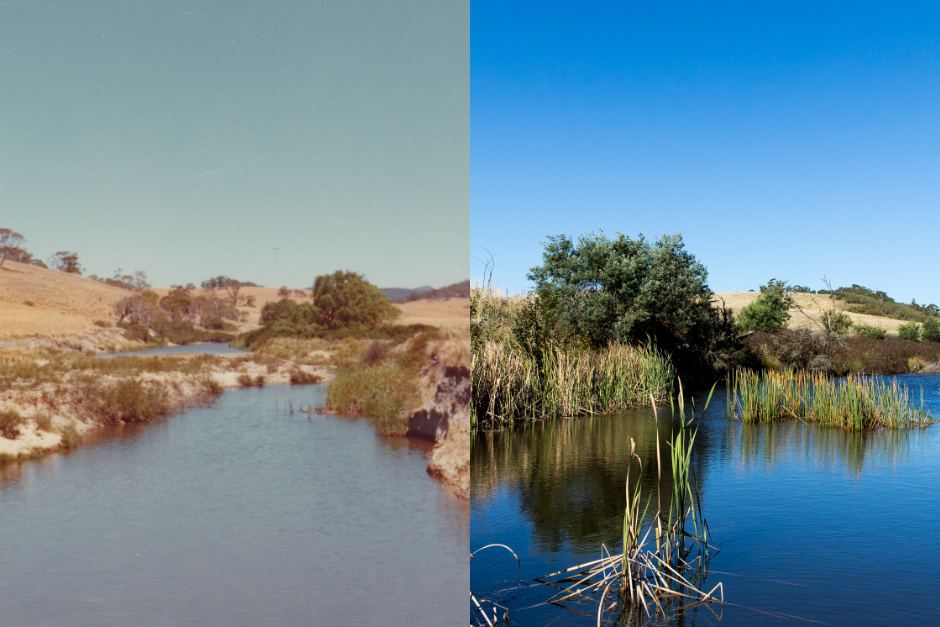Lessons in winning over a sceptical audience from the regenerative agriculture community
Image: The Mulloon Institute – Before and After: Mulloon Creek in 1977 and 2015
Article written by Kimberley Crofts posted here
On Thursday evening I attended my first Transition Bondi Film & Feast night—online of course. The two films were about regenerative agriculture and, after watching them and going down a few other rabbit holes, I realised there is a lot to be learned from the advocates of regenerative farming for convincing sceptics to follow a more sustainable path.
The films
The first film was Regreening the Desert by John D. Liu who is an ecologist and film maker who travels the world sharing and coaching people to regenerate and restore degraded land and restore biodiversity.
The second film was From the Ground Up from Australian film maker Amy Browne. This film spoke of the transformation that the profiled Australian farmers had been through, to change their practices and heal the land.
Both the films focused on a simple premise: that a landscape with water can withstand the worst of droughts. It was my first introduction to the concepts of ‘leaky weirs’ and ‘natural sequence farming’ which are at the core of the practices of these regenerative farmers. You can read more on these concepts on The Conversation, on Peter Andrews website, the site of the Mulloon Institute (you can also do training there), or by watching the excellent Australian Story about Peter Andrews and Tony Coote.
The tips
After watching the films, some common practices emerged as ways in which regenerative farming advocates convince somewhat sceptical audiences.
Get the community involved. This won’t be a surprise to people working in advocacy spaces, but having people from the community involved is key to spread the word and have others embrace sustainable practices. It is also highly important that the people who are telling the story are trusted people within the community. As Tony Coote says in the Australian Story piece:
“You have to have community involved, you have to have the people involved in the land for it to go ahead and that’s what we are able to do, using Peter as the architect for that whole thing.”
Measure your successes. The importance of measuring changes was stressed both in the Australian Story and in the discussion we had with a farmer after the films were shown. This is a hard thing to do but can be the only way to convince some audiences (for example, government) that a change in practice is worth pursuing.
Show don’t (just) tell. Showing the numbers is important, but experiential evidence is also highly powerful. You only need to scroll down to see the YouTube link cover pages to see this. Each has chosen a split screen which shows a regenerative farm on one side, and non-regenerative farming on the other. Throughout the docos there is footage of farmers being shown the regenerated landscape as a way to demonstrate the possibilities and to convince the sceptics.
Sometimes rules need to be broken. Current regulations restrict some regenerative practices taking place. Restrictions exist, for example, on the types of landscaping work that can be done without approvals (leaky weirs are currently not covered), as well as the species that can be planted near rivers and streams (willows are out). Of course there are many more, but these are the key pieces of legislation which are spoken about in the Australian films as barriers to regenerative farming. As Michael Fitzgerald from Mulloon Creek Natural Farms says:
“It took two weeks to get all the stuff in place, but two years to get the paperwork through.”
This is not an uncommon situation: where legislation is yet to catch up with modern practice—and I have heard examples in other disciplines (for example city planning) where legislators have had to be walked through innovative places and then shown where all the rules were being broken. Again, show don’t tell!
To finish, here is some wisdom from Charlie Maslin, one of the farmers profiled in Amy Browne’s From the Ground Up. Thanks to Alex from Transition Bondi for capturing these notes.
- How did you find out about regenerative practices? Charlie was inspired by others work and others are now inspired by him. Some farmers in his region have tried to incorporate Indigenous burning regimes and all recognise the importance of understanding what was here before colonisation as inspiration.
- What made you change? Charlie said that the common theme for change across the case studies presented in Charles Massy’s book Call of the Reed Warbler, was crisis/financial shocks. Generational farmers are comfortable in their practices and require a dramatic event to think about and question habits
- How can more farmers be convinced to change? Charlie said that there are not enough incentives to grow and produce quality food, nor enough information for consumers to make the distinction between produce that is produce with degrading versus regenerative practices. A move towards accreditation from a farmers cooperative could address this issue
- And speaking of incentives… Charlie thinks that Government must provide incentive for regenerative agriculture in a similar way to how we are now talking about supporting and revitalising the Australian manufacturing industry. Additionally, some government funding has been allocated towards a case study to support farmers, to acknowledge the importance of sound soil management practices, and over the last six months the general trend has been very encouraging.
- Follow @charliemaslin on Instagram for more. You might have seen Charlie’s work on the ABC.
Written by


Hello! I found your article on regenerative agriculture quite inspiring. It is wonderful to see communities coming together to embrace sustainable practices.